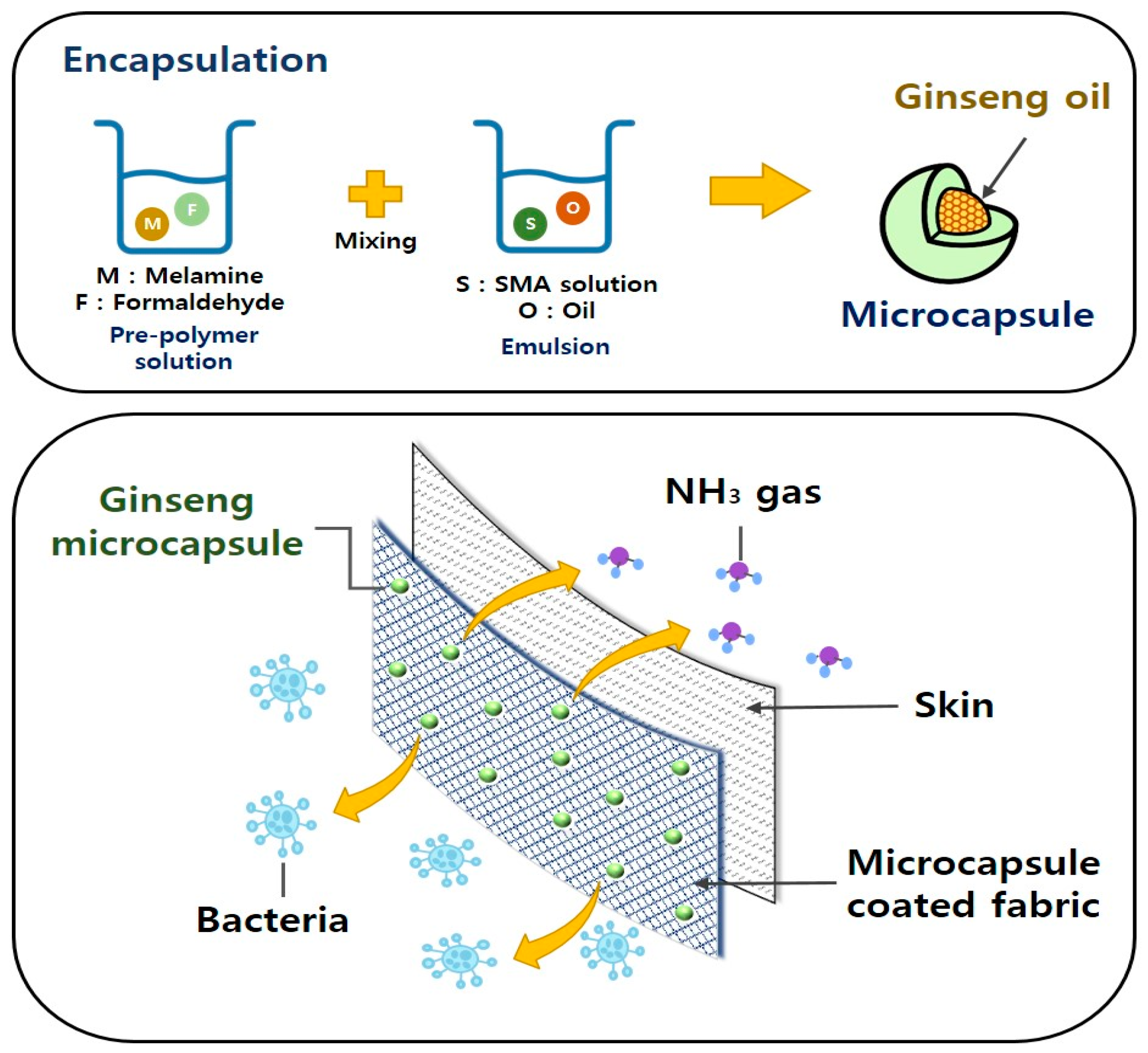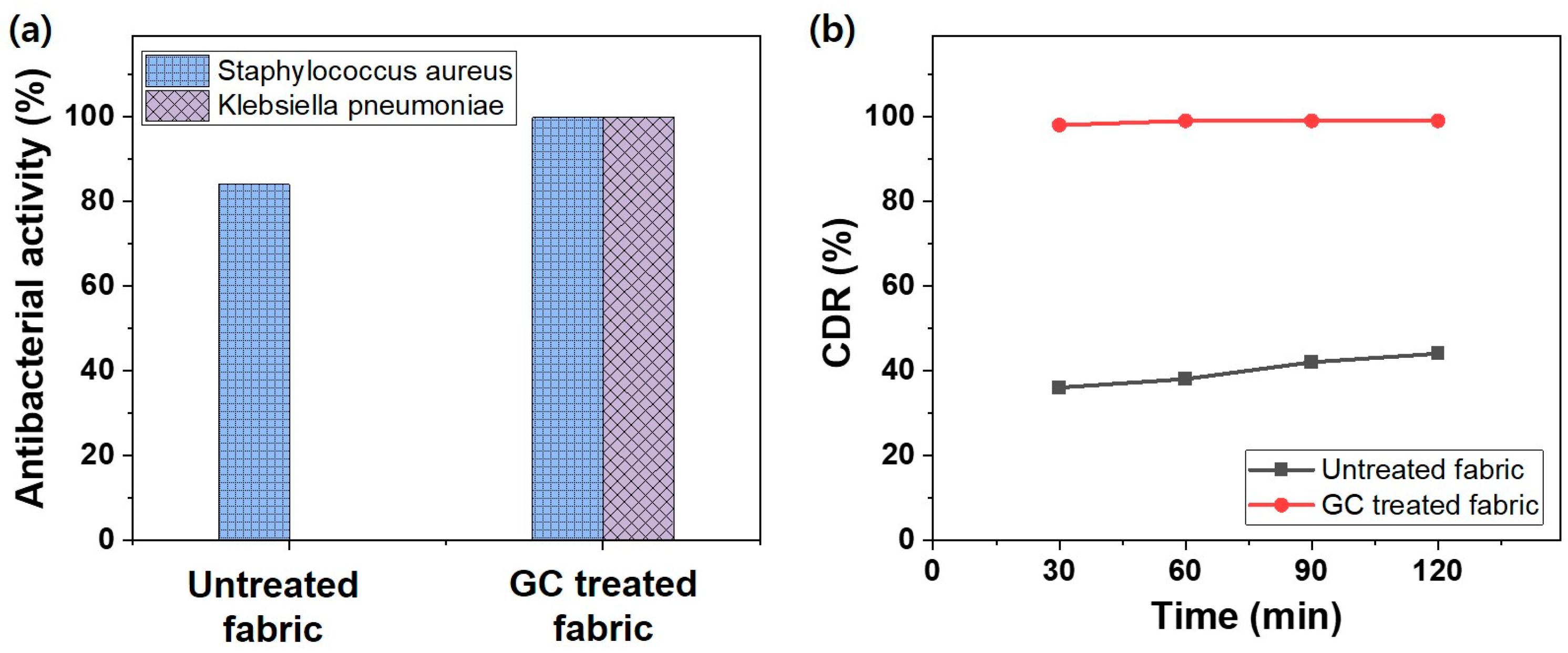Development of Highly Hygienic Textile by Coating with Encapsulated Ginseng Oil
Abstract
:1. Introduction
2. Materials and Methods
2.1. Materials
2.2. Fabrication and Coating of Ginseng Microcapsules
2.3. Characterization
2.4. Functionality Evaluation
3. Results and Discussion
3.1. Fabrication of Ginseng Microcapsules
3.2. Characteristics of the Fabricated Ginseng Microcapsules
3.3. Surface Morphology of Ginseng Microcapsule-Coated Fabric
3.4. Evaluation of Functionality
4. Conclusions
Supplementary Materials
Author Contributions
Funding
Institutional Review Board Statement
Data Availability Statement
Conflicts of Interest
References
- Thadepalli, S. Review of multifarious applications of polymers in medical and health care textiles. Mater. Today Proc. 2022, 55, 330–336. [Google Scholar] [CrossRef]
- Mogensen, J.E.; Jørgensen, P.-E.; Thomsen, T.R. A microbiological evaluation of SiO2-coated textiles in hospital interiors: The effect of passive coatings on the cleaning potential of interior textiles. J. Ind. Text. 2016, 46, 361–371. [Google Scholar] [CrossRef]
- Singh, C.; Wong, C.S.; Wang, X. Medical textiles as vascular implants and their success to mimic natural arteries. J. Funct. Biomater. 2015, 6, 500–525. [Google Scholar] [CrossRef]
- World Health Organization. Air Pollution: The Invisible Health Threat. Available online: https://www.who.int/news-room/feature-stories/detail/air-pollution--the-invisible-health-threat (accessed on 3 October 2023).
- World Health Organization. Tonnes of COVID-19 Health Care Waste Expose Urgent Need to Improve Waste Management Systems. 2022. Available online: https://www.who.int/news/item/01-02-2022-tonnes-of-covid-19-health-care-waste-expose-urgent-need-to-improve-waste-management-systems (accessed on 3 October 2023).
- Bouasria, A.; Nadi, A.; Boukhriss, A.; Hannache, H.; Cherkaoui, O.; Gmouh, S. Advances in polymer coating for functional finishing of textiles. In Frontiers of Textile Materials: Polymers, Nanomaterials, Enzymes, and Advanced Modification Techniques; John Wiley & Sons: Hoboken, NJ, USA, 2020; pp. 61–86. [Google Scholar] [CrossRef]
- Murphy, D.S. Fabric softener technology: A review. J. Surfactants Deterg. 2015, 18, 199–204. [Google Scholar] [CrossRef]
- Lopes, S.; Afonso, C.; Fernandes, I.; Barreiro, M.-F.; Costa, P.; Rodrigues, A.E. Chitosan-cellulose particles as delivery vehicles for limonene fragrance. Ind. Crops Prod. 2019, 139, 111407. [Google Scholar] [CrossRef]
- Xue, J.; Wu, T.; Dai, Y.; Xia, Y. Electrospinning and electrospun nanofibers: Methods, materials, and applications. Chem. Rev. 2019, 119, 5298–5415. [Google Scholar] [CrossRef]
- Black, K.A.; Priftis, D.; Perry, S.L.; Yip, J.; Byun, W.Y.; Tirrell, M. Protein encapsulation via polypeptide complex coacervation. ACS Macro Lett. 2014, 3, 1088–1091. [Google Scholar] [CrossRef]
- Yang, Y.; Du, H.; Zou, G.; Song, Z.; Zhou, Y.; Li, H.; Tan, C.; Chen, H.; Fischetti, V.A.; Li, J. Encapsulation and delivery of phage as a novel method for gut flora manipulation in situ: A review. J. Control. Release 2023, 353, 634–649. [Google Scholar] [CrossRef]
- Anandharamakrishnan, C. Spray Drying Techniques for Food Ingredient Encapsulation; John Wiley & Sons: Hoboken, NJ, USA, 2015. [Google Scholar]
- Salaün, F.; Bedek, G.; Devaux, E.; Dupont, D.; Gengembre, L. Microencapsulation of a cooling agent by interfacial polymerization: Influence of the parameters of encapsulation on poly (urethane–urea) microparticles characteristics. J. Membr. Sci. 2011, 370, 23–33. [Google Scholar] [CrossRef]
- Ai, H.; Jones, S.A.; de Villiers, M.M.; Lvov, Y.M. Nano-encapsulation of furosemide microcrystals for controlled drug release. J. Control. Release 2003, 86, 59–68. [Google Scholar] [CrossRef]
- Risch, S.J. Encapsulation: Overview of Uses and Techniques; ACS Publication: Washington, DC, USA, 1995. [Google Scholar] [CrossRef]
- Gharsallaoui, A.; Roudaut, G.; Chambin, O.; Voilley, A.; Saurel, R. Applications of spray-drying in microencapsulation of food ingredients: An overview. Food Res. Int. 2007, 40, 1107–1121. [Google Scholar] [CrossRef]
- Shishir, M.R.I.; Chen, W. Trends of spray drying: A critical review on drying of fruit and vegetable juices. Trends Food Sci. Technol. 2017, 65, 49–67. [Google Scholar] [CrossRef]
- Martins, I.M.; Barreiro, M.F.; Coelho, M.; Rodrigues, A.E. Microencapsulation of essential oils with biodegradable polymeric carriers for cosmetic applications. Chem. Eng. J. 2014, 245, 191–200. [Google Scholar] [CrossRef]
- Timilsena, Y.P.; Akanbi, T.O.; Khalid, N.; Adhikari, B.; Barrow, C.J. Complex coacervation: Principles, mechanisms and applications in microencapsulation. Int. J. Biol. Macromol. 2019, 121, 1276–1286. [Google Scholar] [CrossRef]
- Zhang, Z.; Zhang, Z.; Chang, T.; Wang, J.; Wang, X.; Zhou, G. Phase change material microcapsules with melamine resin shell via cellulose nanocrystal stabilized Pickering emulsion in-situ polymerization. Chem. Eng. J. 2022, 428, 131164. [Google Scholar] [CrossRef]
- Zotiadis, C.; Patrikalos, I.; Loukaidou, V.; Korres, D.M.; Karantonis, A.; Vouyiouka, S. Self-healing coatings based on poly (urea-formaldehyde) microcapsules: In situ polymerization, capsule properties and application. Prog. Org. Coat. 2021, 161, 106475. [Google Scholar] [CrossRef]
- Chen, T.; Wu, Y.; Qiu, J.; Fei, M.; Qiu, R.; Liu, W. Interfacial compatibilization via in-situ polymerization of epoxidized soybean oil for bamboo fibers reinforced poly (lactic acid) biocomposites. Compos. Part A Appl. Sci. Manuf. 2020, 138, 106066. [Google Scholar] [CrossRef]
- Ghayempour, S.; Montazer, M. Micro/nanoencapsulation of essential oils and fragrances: Focus on perfumed, antimicrobial, mosquito-repellent and medical textiles. J. Microencapsul. 2016, 33, 497–510. [Google Scholar] [CrossRef] [PubMed]
- Asadi Fard, P.; Shakoorjavan, S.; Akbari, S. The relationship between odour intensity and antibacterial durability of encapsulated thyme essential oil by PPI dendrimer on cotton fabrics. J. Text. Inst. 2018, 109, 832–841. [Google Scholar] [CrossRef]
- Javid, A.; Raza, Z.A.; Hussain, T.; Rehman, A. Chitosan microencapsulation of various essential oils to enhance the functional properties of cotton fabric. J. Microencapsul. 2014, 31, 461–468. [Google Scholar] [CrossRef]
- Sharkawy, A.; Fernandes, I.P.; Barreiro, M.F.; Rodrigues, A.E.; Shoeib, T. Aroma-loaded microcapsules with antibacterial activity for eco-friendly textile application: Synthesis, characterization, release, and green grafting. Ind. Eng. Chem. Res. 2017, 56, 5516–5526. [Google Scholar] [CrossRef]
- Rajendran, R.; Radhai, R.; Kotresh, T.; Csiszar, E. Development of antimicrobial cotton fabrics using herb loaded nanoparticles. Carbohydr. Polym. 2013, 91, 613–617. [Google Scholar] [CrossRef] [PubMed]
- Ghayempour, S.; Montazer, M.; Rad, M.M. Simultaneous encapsulation and stabilization of Aloe vera extract on cotton fabric for wound dressing application. RSC Adv. 2016, 6, 111895–111902. [Google Scholar] [CrossRef]
- Subair, S.; Singh, N.; Maru, M.; Prakash, S.; Hasanar, M. An Antimicrobial Fabric Using Nano-Herbal Encapsulation of Essential Oils. J. Vis. Exp. 2023, 7, e65187. [Google Scholar] [CrossRef]
- Ghayempour, S.; Montazer, M. Herbal products on cellulosic fabric with controlled release: Comparison of in situ encapsulation and UV curing of the prepared nanocapsules. Cellulose 2017, 24, 4033–4043. [Google Scholar] [CrossRef]
- Truong, V.-L.; Jeong, W.-S. Red ginseng (Panax ginseng Meyer) oil: A comprehensive review of extraction technologies, chemical composition, health benefits, molecular mechanisms, and safety. J. Ginseng Res. 2022, 46, 214–224. [Google Scholar] [CrossRef]
- Zhou, W.; Chai, H.; Lin, P.H.; Lumsden, A.B.; Yao, Q.; Chen, C. Molecular mechanisms and clinical applications of ginseng root for cardiovascular disease. Med. Sci. Monit. 2004, 10, RA187–RA192. [Google Scholar]
- Kim, H.J.; Kang, H.J.; Seo, J.Y.; Lee, C.H.; Kim, Y.-S.; Kim, J.-S. Antiobesity effect of oil extract of ginseng. J. Med. Food 2011, 14, 573–583. [Google Scholar] [CrossRef]
- ISO 20645:2006; Flat Products—Determination of Antimicrobial Activity–Diffusion Method on Agar Plate. International Organization for Standardization: Geneva, Switzerland, 2006.
- Marathe, R.J.; Chaudhari, A.B.; Hedaoo, R.K.; Sohn, D.; Chaudhari, V.R.; Gite, V.V. Urea formaldehyde (UF) microcapsules loaded with corrosion inhibitor for enhancing the anti-corrosive properties of acrylic-based multi-functional PU coatings. RSC Adv. 2015, 5, 15539–15546. [Google Scholar] [CrossRef]
- Su, J.-F.; Wang, X.-Y.; Dong, H. Micromechanical properties of melamine–formaldehyde microcapsules by nanoindentation: Effect of size and shell thickness. Mater. Lett. 2012, 89, 1–4. [Google Scholar] [CrossRef]
- Gan, W.; Yang, H.; Zhang, Y.; Shi, S.Q.; Lin, C.; Pan, L.; Huang, Z. Synthesis and characterization of sucrose-melamine-formaldehyde adhesives. Bioresources 2016, 11, 2516–2525. [Google Scholar] [CrossRef]
- Wang, D.; Zhang, X.; Luo, S.; Li, S. Preparation and property analysis of melamine formaldehyde foam. Adv. Mater. Phys. Chem 2012, 2, 63–67. [Google Scholar] [CrossRef]
- Jiang, G.; Ramachandraiah, K.; Tan, C.; Cai, N.; Ameer, K.; Feng, X. Modification of Ginseng Insoluble Dietary Fiber by Enzymatic Method: Structural, Rheological, Thermal and Functional Properties. Foods 2023, 12, 2809. [Google Scholar] [CrossRef]
- Caldeira, E.; Piskin, E.; Granadeiro, L.; Silva, F.; Gouveia, I.C. Biofunctionalization of cellulosic fibres with l-cysteine: Assessment of antibacterial properties and mechanism of action against Staphylococcus aureus and Klebsiella pneumoniae. J. Biotechnol. 2013, 168, 426–435. [Google Scholar] [CrossRef]
- Shin, Y.; Yoo, D.I.; Min, K. Antimicrobial finishing of polypropylene nonwoven fabric by treatment with chitosan oligomer. J. Appl. Polym. Sci. 1999, 74, 2911–2916. [Google Scholar] [CrossRef]
- Gaskin, S.; Pisaniello, D.; Edwards, J.W.; Bromwich, D.; Reed, S.; Logan, M.; Baxter, C. Application of skin contamination studies of ammonia gas for management of hazardous material incidents. J. Hazard. Mater. 2013, 252, 338–346. [Google Scholar] [CrossRef] [PubMed]






Disclaimer/Publisher’s Note: The statements, opinions and data contained in all publications are solely those of the individual author(s) and contributor(s) and not of MDPI and/or the editor(s). MDPI and/or the editor(s) disclaim responsibility for any injury to people or property resulting from any ideas, methods, instructions or products referred to in the content. |
© 2023 by the authors. Licensee MDPI, Basel, Switzerland. This article is an open access article distributed under the terms and conditions of the Creative Commons Attribution (CC BY) license (https://creativecommons.org/licenses/by/4.0/).
Share and Cite
Ryu, S.; Shim, J. Development of Highly Hygienic Textile by Coating with Encapsulated Ginseng Oil. Polymers 2023, 15, 4352. https://doi.org/10.3390/polym15224352
Ryu S, Shim J. Development of Highly Hygienic Textile by Coating with Encapsulated Ginseng Oil. Polymers. 2023; 15(22):4352. https://doi.org/10.3390/polym15224352
Chicago/Turabian StyleRyu, Sujin, and Jaeyun Shim. 2023. "Development of Highly Hygienic Textile by Coating with Encapsulated Ginseng Oil" Polymers 15, no. 22: 4352. https://doi.org/10.3390/polym15224352
APA StyleRyu, S., & Shim, J. (2023). Development of Highly Hygienic Textile by Coating with Encapsulated Ginseng Oil. Polymers, 15(22), 4352. https://doi.org/10.3390/polym15224352





